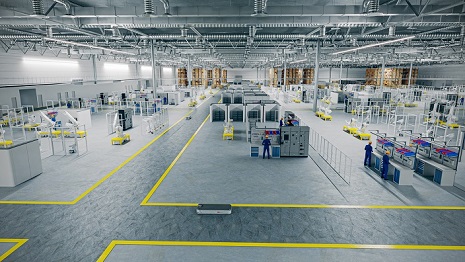ABB to invest $280 million in its European robotics hub in Sweden
Significant upgrade of the site in Västerås follows recent investments in China and the United States. The new campus is planned to open in late 2026.

ABB today announced an investment of $280 million to expand its manufacturing footprint in Europe and build a new state-of-the-art ABB Robotics European Campus in Västerås, Sweden. The Campus will serve as the hub for ABB Robotics’ offering in Europe, providing customers with artificial intelligence (AI)-enabled collaborative and industrial robots, as well as digital solutions to support flexible automation, the company said.
Replacing the existing robotics facilities at the site, the new Campus is planned to open in late 2026.
“The investment in our new Campus is driven by customer demand and projected market growth,” said Björn Rosengren, ABB CEO. “Following important investments in China and the U.S, the new facility in Sweden will strengthen our capabilities in serving our customers in Europe with locally manufactured products in a growing market. Already today, around 95 percent of the robots ABB sells in the region are manufactured here. This is a strong commitment not only to our “local for local” strategy, but to all our robotics customers across Europe.”
ABB explained its investment in the Robotics Campus in Västerås will enhance its robotics and automation leadership globally. With the facility, ABB will expand production capacity by 50 percent and strengthen its capabilities to supply the European market for robotics, which is expected to grow at a 7% CAGR through 2027 in terms of shipments, according to market intelligence firm Interact Analysis. When the campus is completed, ABB will have invested $450 million in its three robotics facilities since 2018, including its mega factory in Shanghai that supplies customers in Asia, and its Auburn Hills facility that supports the Americas.
“This is a great time to invest in robotics and automation. This new Campus is a significant part of our global growth story and key in supporting our European customers as they accelerate investment in robotics and AI due to the reshoring of industry, the move to more sustainable supply chains and long-term labor shortages,” said Sami Atiya, President of ABB’s Robotics & Discrete Automation Business Area. “Our Robotics Campus will help us to serve our customers more efficiently and support new and existing sectors like automotive, electronics, logistics, healthcare, e-commerce and pharmaceuticals to unlock the full potential of automation.”
ABB’s new Campus will enable close collaboration with customers and partners to develop robotics and automation solutions in a safe and functional environment, the company added. Customers will be able to test their solutions and experiment with the latest automation innovations on-site. In addition, employees, visitors, and students alike will be able to take part in an open and lively Campus, both during and after office hours.
“Our new, sustainable facility in Sweden will be located at the cradle of ABB Robotics' global innovation, starting with ABB’s development of the world's first commercial all-electric robot nearly 50 years ago,” added Marc Segura, President of ABB Robotics. “In our new R&D center, we are focusing on the development of new digital and AI-enabled technologies, making robots increasingly accessible while lowering the entry barrier for applications in all industries.”
The 65,000 square meters Campus will be a modern workplace for ABB Robotics’ workforce of 1,300 in the area and include a new factory, offices, a research and development center, an experience center and a training center for customers and visitors. The new factory will also feature autonomous mobile robots (AMRs) as a key component in transporting materials and products between the warehouse, assembly stations and assembly departments.
The construction is planned to start in 2024 and will replace the nine separate buildings that have grown organically since 1974 and currently constitute the robotics operations in Sweden, which ABB sees as further strengthening cross-functional synergies. See here for an ABB video explaining the project and its purpose.
By building the Campus in Västerås, ABB continues to consolidate the area as an automation cluster, staying in important proximity to customers, suppliers, academia, and partners, ABB added.
The campus will be constructed in line with ABB’s 2030 Sustainability Targets that aim towards carbon neutrality within ABB’s operations by reducing greenhouse gas emissions and increasing preservation of resources. To support this, consideration will be made in the selection of building materials and construction processes as well as in the use of solar panels on the roof.

Article Topics
ABB News & Resources
ABB opens refitted U.S. robotics facility in Auburn Hills, Michigan ABB acquires AI-based autonomous navigation technology provider Sevensense ABB to invest $280 million in its European robotics hub in Sweden ABB completes acquisition of Siemens low voltage NEMA motor business ABB to expand its robotics factory in Michigan ABB survey finds risk from global “education gap” in automation ABB to acquire Siemens low voltage NEMA motor business More ABBLatest in Materials Handling
Geek+ and System Teknik deploy PopPick solution for pharmacy group Med24.dk Beckhoff USA opens new office in Austin, Texas Manhattan Associates selects TeamViewer as partner for warehouse vision picking ASME Foundation wins grant for technical workforce development The (Not So) Secret Weapons: How Key Cabinets and Asset Management Lockers Are Changing Supply Chain Operations MODEX C-Suite Interview with Harold Vanasse: The perfect blend of automation and sustainability Consultant and industry leader John M. Hill passes on at age 86 More Materials HandlingSubscribe to Materials Handling Magazine

Find out what the world's most innovative companies are doing to improve productivity in their plants and distribution centers.
Start your FREE subscription today.
April 2024 Modern Materials Handling

Latest Resources










